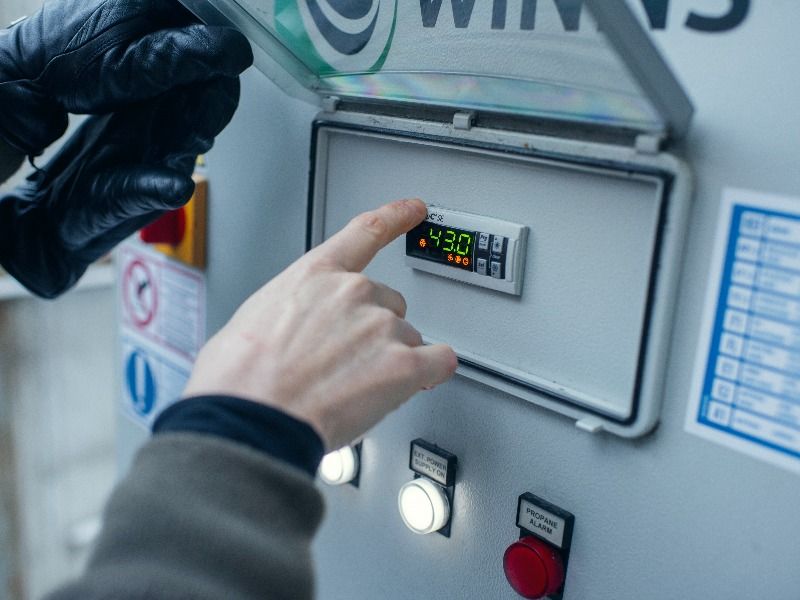
CO2 is your easiest way to a provision stores refrigeration system. It lasts the lifetime of the installation. Winns basic unit fits 95% of the LQ's provision stores applications.

There are no longer need for chemical refrigerants in any known refrigeration application. Winns has taken a leading role in this implementation.

It’s a system for living quarters, where the potential for reducing virgin electric power supply is massive, in a typical Offshore Living Quarter (LQ)

CO₂ is your easiest way to a provision stores refrigeration system. It lasts the lifetime of the installation. Winns basic unit fits 95% of the LQ's provision stores applications.

There are no longer need for synthetical refrigerants in any known refrigeration application. Winns has taken a leading role in this implementation.

It’s a system for living quarters, where the potential for reducing virgin electric power supply is massive, in a typical Offshore Living Quarter (LQ)

CO₂ is your easiest way to a provision stores refrigeration system. It lasts the lifetime of the installation. Winns basic unit fits 95% of the LQ's provision stores applications.

There are no longer need for synthetical refrigerants in any known refrigeration application. Winns has taken a leading role in this implementation.

It’s a system for living quarters, where the potential for reducing virgin electric power supply is massive, in a typical Offshore Living Quarter (LQ)
Winns was established in 2014 to contribute to the world’s most important task. Drastically cut greenhouse gas emissions. We have been delivering heating and cooling systems offshore, using natural CO₂ as a refrigerant, for many years. Our employees are specialists in natural refrigeration technology and have long and valuable experience in different fields within the oil and gas industry.
Winns was established in 2014 to contribute to the world’s most important task. Drastically cut greenhouse gas emissions. We have been delivering heating and cooling systems offshore, using natural CO₂ as a refrigerant, for many years. Our employees are specialists in natural refrigeration technology and have long and valuable experience in different fields within the oil and gas industry.
Winns was established in 2014 to contribute to the world’s most important task. Drastically cut greenhouse gas emissions. We have been delivering heating and cooling systems offshore, using natural CO₂ as a refrigerant, for many years. Our employees are specialists in natural refrigeration technology and have long and valuable experience in different fields within the oil and gas industry.
Since the German breweries in the early 1800s needed cooling for their beer brewing processes, natural refrigerants have been used in cooling systems.
But, from the 1930s and forward, synthetical mixtures of various CFC’s (Chlorofluorocarbons) were introduced as a “safer” alternative to CO₂. Today we know that Chlorofluorocarbons from refrigeration have caused large holes in the protective Ozone layer around our globe, and they still do.
Whereas CFC’s destroys the Ozon layer, the newer HFC’s (Hydrofluorocarbon), used worldwide don’t impact the Ozone layer, but they contributes immensely to global warming, and some of them are in a PFAS group that five EU countries intend to restrict.
The newest synthetic refrigerants HFO’s (hydrofluoroolefin) are marketed as environmentally friendly, but have lately been classified as PFAS, also known as “for ever chemicals” that the five EU countries intend to restrict. Numerous studies have shown that not only do HFO’s contribute immensely to global warming, but they also pollute the drinking water.


Since the German breweries in the early 1800s needed cooling for their beer brewing processes, natural refrigerants have been used in cooling systems.
But, from the 1930s and forward, synthetical mixtures of various CFC’s (Chlorofluorocarbons) were introduced as a “safer” alternative to CO₂. Today we know that Chlorofluorocarbons from refrigeration have caused large holes in the protective Ozone layer around our globe, and they still do.
Whereas CFC’s destroys the Ozon layer, the newer HFC’s (Hydrofluorocarbon), used worldwide don’t impact the Ozone layer, but they contributes immensely to global warming, and some of them are in a PFAS group that five EU countries intend to restrict.
The newest synthetic refrigerants HFO’s (hydrofluoroolefin) are marketed as environmentally friendly, but have lately been classified as PFAS, also known as “for ever chemicals” that the five EU countries intend to restrict. Numerous studies have shown that not only do HFO’s contribute immensely to global warming, but they also pollute the drinking water.

Since the German breweries in the early 1800s needed cooling for their beer brewing processes, natural refrigerants have been used in cooling systems.
But, from the 1930s and forward, synthetical mixtures of various CFC’s (Chlorofluorocarbons) were introduced as a “safer” alternative to CO₂. Today we know that Chlorofluorocarbons from refrigeration have caused large holes in the protective Ozone layer around our globe, and they still do.
Whereas CFC’s destroys the Ozon layer, the newer HFC’s (Hydrofluorocarbon), used worldwide don’t impact the Ozone layer, but they contributes immensely to global warming, and some of them are in a PFAS group that five EU countries intend to restrict.
The newest synthetic refrigerants HFO’s (hydrofluoroolefin) are marketed as environmentally friendly, but have lately been classified as PFAS, also known as “for ever chemicals” that the five EU countries intend to restrict. Numerous studies have shown that not only do HFO’s contribute immensely to global warming, but they also pollute the drinking water.
The following is an attempt to give you all facts you need to understand Winns environmentally friendly heating and cooling technology with natural CO₂.
CO₂ is a naturally occurring substance contributing to global warming, used as a unit of measure for other non-natural substances in regard to the Global Warming Potential (GWP). 1 GWP equals 1 kg of CO₂.
Let’s compare: A typical refrigeration system contains 50 kg of HFC gas (like R134 with a GWP of 1480). If this gas is leaking out, the atmosphere has to deal with equal to 74.000 kg of CO2. And this is just a small refrigeration system. If we use CO₂ as a refrigerant in the same size system, 50 kg CO2 in is 50 kg CO₂ out.
So easy. So important.

The following is an attempt to give you all facts you need to understand Winns environmentally friendly heating and cooling technology with natural CO₂.
CO₂ is a naturally occurring substance contributing to global warming, used as a unit of measure for other non-natural substances in regard to the Global Warming Potential (GWP). 1 GWP equals 1 kg of CO₂.
Let’s compare: A typical refrigeration system contains 50 kg of HFC gas (like R134 with a GWP of 1480). If this gas is leaking out, the atmosphere has to deal with equal to 74.000 kg of CO2. And this is just a small refrigeration system. If we use CO₂ as a refrigerant in the same size system, 50 kg CO2 in is 50 kg CO₂ out.
So easy. So important.

The following is an attempt to give you all facts you need to understand Winns environmentally friendly heating and cooling technology with natural CO₂.
CO₂ is a naturally occurring substance contributing to global warming, used as a unit of measure for other non-natural substances in regard to the Global Warming Potential (GWP). 1 GWP equals 1 kg of CO₂.
Let’s compare: A typical refrigeration system contains 50 kg of HFC gas (like R134 with a GWP of 1480). If this gas is leaking out, the atmosphere has to deal with equal to 74.000 kg of CO2. And this is just a small refrigeration system. If we use CO₂ as a refrigerant in the same size system, 50 kg CO₂ in is 50 kg CO₂ out.
So easy. So important.

Winns Offshore © 2024 | Design by Byrået